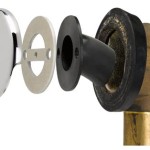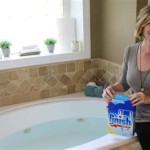Acrylic vs. Fiberglass Bathtubs: A Comprehensive Comparison
When undertaking a bathroom renovation or new construction project, selecting the right bathtub is a critical decision. Two popular materials often considered are acrylic and fiberglass. Both offer a range of benefits and drawbacks, making it essential to understand their differences before making a purchase. This article delves into a comprehensive comparison of acrylic and fiberglass bathtubs, examining their construction, durability, aesthetics, cost, and other important factors to help informed decision-making.
Fiberglass bathtubs are constructed from layers of glass fibers reinforced with resin. A gel coat is typically applied to provide a smooth and glossy surface. This manufacturing process makes fiberglass relatively lightweight and inexpensive. However, the thinness of the material can lead to flexing and cracking over time, especially in areas of high stress.
Acrylic bathtubs, on the other hand, are made from sheets of acrylic that are vacuum-formed over a mold. The acrylic sheet is then reinforced with fiberglass for added strength. This construction method results in a thicker, more durable bathtub compared to fiberglass alone. The acrylic surface is also less porous, making it more resistant to staining and chipping.
Durability and Longevity
One of the primary considerations when choosing a bathtub is its durability. A bathtub that can withstand daily use and resist damage will offer a longer lifespan and reduce the need for costly repairs or replacements. In this regard, acrylic bathtubs generally outperform fiberglass models. The thicker acrylic layer provides superior impact resistance and reduces the likelihood of cracks and chips. The reinforcement with fiberglass provides further structural support.
Fiberglass bathtubs, being thinner and less rigid, are more susceptible to damage. The gel coat surface can become scratched or stained easily, and the underlying fiberglass can crack under pressure. While repairs are possible, they may not fully restore the bathtub to its original condition, and the repair may be visible. The lifespan of a fiberglass bathtub is typically shorter than that of an acrylic bathtub, particularly with frequent use and heavy impacts.
The support structure beneath the tub is also vital. Both fiberglass and acrylic tubs can benefit from a level and well-supported base. Ensuring the subfloor is even before installation, and adding mortar or a foam support system beneath the tub, can significantly extend its life regardless of the material.
Aesthetics and Design Options
The aesthetic appeal of a bathtub plays a significant role in the overall look and feel of a bathroom. Both acrylic and fiberglass bathtubs are available in a variety of shapes, sizes, and colors, but there are some key differences in their design capabilities. Acrylic bathtubs offer greater design flexibility due to the manufacturing process. The acrylic sheet can be molded into more complex shapes and designs, including integrated armrests, contoured backrests, and sculpted features.
Fiberglass bathtubs are generally limited to simpler designs due to the constraints of the molding process. While they are available in a range of colors, the gel coat surface may not offer the same level of depth and luster as acrylic. Over time, the gel coat can also fade or yellow, affecting the bathtub's aesthetic appeal. Acrylic's color is often integrated throughout the material, making scratches less noticeable.
The finish quality also affects the appearance. Acrylic tubs tend to have a smoother, more consistent surface than fiberglass tubs. This superior finish contributes to a more luxurious and visually appealing bathtub. The non-porous nature of acrylic also helps to maintain its shine and resist staining, keeping the bathtub looking newer for longer.
Heat Retention and Insulation
Heat retention is an important factor for bathers who enjoy long, relaxing soaks. A bathtub that can maintain water temperature for an extended period will provide a more comfortable and enjoyable bathing experience. Acrylic bathtubs generally offer better heat retention than fiberglass bathtubs. The thicker acrylic material acts as a natural insulator, slowing down the rate at which heat is lost from the water.
Fiberglass, being a thinner material, offers less insulation. The water in a fiberglass bathtub will tend to cool down more quickly, requiring bathers to add hot water more frequently to maintain their desired temperature. This can be inconvenient and potentially increase water heating costs. Additional insulation can be installed around the exterior of either tub type to improve heat retention.
The thermal properties of acrylic also contribute to a more comfortable bathing experience. The surface of an acrylic bathtub is typically warmer to the touch than that of a fiberglass bathtub. This can be particularly noticeable in colder climates, where a warm bathtub surface can make a significant difference in comfort.
Maintenance and Cleaning
Ease of maintenance is a crucial consideration for busy homeowners. A bathtub that is easy to clean and resistant to staining will save time and effort. Acrylic bathtubs are generally easier to maintain than fiberglass bathtubs. The non-porous surface of acrylic resists staining and mildew growth, making it easier to clean with mild soap and water.
Fiberglass bathtubs, with their more porous gel coat surface, are more prone to staining and mildew. Harsh chemical cleaners should be avoided as they can damage the gel coat and dull the finish. Regular cleaning with a non-abrasive cleaner is recommended to maintain the appearance of a fiberglass bathtub.
Repairing minor scratches and chips is also easier with acrylic bathtubs. Acrylic repair kits are readily available and can be used to fill in small imperfections. Fiberglass repairs are more complex and may require professional assistance to ensure a seamless finish. Regular cleaning, regardless of material, is essential to prevent the buildup of soap scum and hard water stains.
Cost Comparison
The cost of a bathtub is a significant factor for many homeowners. Fiberglass bathtubs are generally less expensive than acrylic bathtubs. This is due to the simpler manufacturing process and the lower cost of materials. Fiberglass bathtubs are a budget-friendly option for those looking to save money on their bathroom renovation project.
Acrylic bathtubs, while more expensive upfront, may offer better value in the long run due to their increased durability and longer lifespan. While the initial investment is higher, the reduced need for repairs and replacements can offset the cost difference over time. Moreover, the superior aesthetics and enhanced features of acrylic bathtubs can also increase the overall value of the bathroom and the home.
Installation costs can also vary depending on the complexity of the project. Replacing an existing bathtub with a similar model is typically less expensive than installing a new bathtub in a different location or with different plumbing configurations. Obtaining quotes from multiple contractors is recommended to compare prices and ensure a fair deal.
Weight and Installation
The weight of a bathtub can impact the ease of installation and the structural requirements of the bathroom floor. Fiberglass bathtubs are typically lighter than acrylic bathtubs, making them easier to maneuver and install. This can be particularly advantageous in older homes where the floor may not be able to support the weight of a heavier bathtub.
Acrylic bathtubs, being thicker and more heavily reinforced, are generally heavier. While this contributes to their increased durability, it can also make installation more challenging. Additional manpower or specialized equipment may be required to lift and position an acrylic bathtub. The subfloor should also be inspected to ensure it can support the weight of the bathtub when filled with water.
Regardless of the material, proper installation is crucial to ensure the bathtub functions properly and lasts for many years. A qualified plumber should be hired to install the bathtub, ensuring that all connections are secure and watertight. Proper leveling and support are also essential to prevent flexing and cracking.
Environmental Considerations
Environmental concerns are increasingly influencing purchasing decisions. Both acrylic and fiberglass bathtubs have environmental impacts associated with their manufacturing and disposal. Acrylic production involves the use of petroleum-based products, which contributes to carbon emissions and resource depletion. However, acrylic bathtubs are often more durable and have a longer lifespan, which can reduce the need for frequent replacements and minimize waste.
Fiberglass bathtubs also have environmental impacts. The production of fiberglass involves the use of resins and solvents, which can contribute to air and water pollution. Additionally, fiberglass is difficult to recycle, and most fiberglass bathtubs end up in landfills at the end of their lifespan. Choosing bathtubs made with recycled materials or those from manufacturers with sustainable practices can help minimize the environmental impact.
The energy consumption associated with heating water for baths also contributes to the overall environmental footprint. Choosing a bathtub with good heat retention can help reduce energy consumption by minimizing the need to add hot water during a bath. Installing a low-flow showerhead can also help conserve water and energy.

Acrylic Vs Fiberglass Tub Which Material Is Best For You

Acrylic Vs Fiberglass Tub What S The Difference American Standard Walk In Tubs

Can Plastic Acrylic Or Fiberglass Bathtubs Shower Stalls Be Reglazed Refinished America Refinishing Pros

What Bathtub Material Is In My Bathroom Maryland Tub Tile

4 Common Bathtub Materials Pros Cons What To Buy For Your Bathroom

Acrylic Vs Fiberglass Tub What S The Difference

Should You Choose A Fiberglass Or Acrylic Tub

Acrylic Vs Fiberglass Tub Long Home S

The Best Bathtub Material Acrylic Vs Resin Long Home

Bathtubs Showers Acrylic Vs Fiberglass Home








